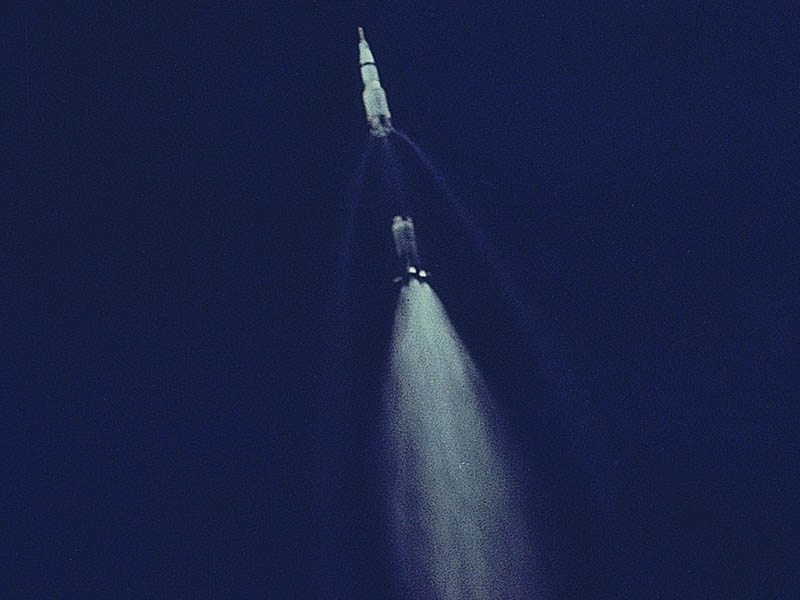Title image is Ariane 5 flight VA252 on 18 February 2020 lifting off from Europe’s Spaceport in French Guiana. Image credit: ESA/CNES/Arianespace
Humanity has dreamt of traveling into space for, at least, two-thousand years. In what’s considered the earliest known fiction about travel to outer space, alien life-forms, and interplanetary warfare, in the year 150 Lucian of Samosata wrote True History (Greek: Αληθής Ιστορία). In part of this, the heroes are swept upwards in a giant waterspout. After seven days and seven nights, they arrive on the Moon to find themselves embroiled in a war between the King of the Moon and the King of the Sun over the Morning Star (that’s Venus). The Sun wins.
From then until Jules Verne’s novel From Earth to the Moon (French: De la Terre à la Lune) in the 1860’s many fanciful tales were told of humanity’s travels beyond Earth. One of the more curious is by Cyrano de Bergerac, from 1657 in Comical History of the States and Empires of the Moon. In this he reasoned that the dew on morning grass disappearing in daytime meant that the Sun must ‘suck’ up the dew. So, if enough dew was collected and stored in bottles he need only stand on his lawn in a fine morning and the Sun will ‘suck’ him up along with the morning dew. Unfortunately, or maybe fortunately it’s somewhat more difficult than this.
It wasn’t until shortly after From Earth to the Moon that space travel became a seriously considered engineering endeavour through the works of Konstantin Tsiolkovsky, a school teacher who would become the father of cosmonautics.
Tsiolkovsky credited Verne’s novel with planting the “seeds of curiosity” which led to his calculations of the motion of a rocket, and laying the foundations to inspire generations of engineers that followed him. Amongst his work, Tsiolkovsky determined for the first time the speed required to reach orbit, around 8km/s.
To access space a dedicated vehicle is required, a launch vehicle, often simply called a launcher or rocket, after its propulsion method. The launcher’s function is to deliver spacecraft to space; this is done inside the payload fairing, located in the rocket’s nose cone.
As well as placing the spacecraft into orbit, the launcher must also protect it. Yet, the launcher itself will place challenging vibration and acoustic demands onto the spacecraft’s design. The allowable level of these, and launcher design features such as the expected mean time between failures, safety requirements, and the level of protection offered are driven by the purpose of the spacecraft being transported.
A system is termed safety critical if a failure risks human life. If the spacecraft has people on-board then the launcher will likely have an escape, or launch abort system to quickly separate the spacecraft, and its crew, from the launcher in an emergency.
A system is mission critical if a failure does not risk human life, but merely the function of the system. It would be unusual to implement a launch abort system for a robotic spacecraft due to the added complexity and cost. However, certain customers, typically government, will demand higher reliability standards short of such an abort system, and will be willing to pay for this added assurance.
To access space requires a lot of energy; upwards of 34MJ/kg, increasing as altitude increases. By comparison, a car driving 180 km/h has the equivalent energy of only 0.004% (1.25kJ/kg) of that. To deliver the required amount of energy from a single rocket is immensely challenging. Several concepts for so-called single-stage-to-orbit vehicles have been proposed, in-theory enabling a fully reusable launcher, however no such launcher has been developed for use from Earth.
Instead we use multistage rockets, these are two or more rockets, or stages working in sequence. The simplest is two rockets stacked on top of each other, the first stage is the bottom one, which fires first, and it’s usually the largest, with each subsequent stage tending to be smaller than its predecessor.
Each stage can actually have either one or more rockets working together, and some multi-stage rockets have as many as five stages.
Once a stage has completed its burn it is jettisoned. This is termed stage separation and means the remaining stages have less to lift. It also means each stage can be designed for its specific operating conditions as the launcher progresses through the atmosphere.

Some launchers will replace the first stage, or part of its function with an aircraft, creating an air-launch system where the launcher is carrier to a target altitude before being detached, and igniting.
When launching towards equatorial orbit, using launch pads with low latitudes, so closer to the equator, provides a benefit from the Earth’s rotation. However, aiming at polar orbits this rotation is of no value and so high latitude launch sites can be used.
In theory, rockets are not the only way to get a spacecraft into space, although they are the only way we managed it so far. And so, whilst some people are trying to make space more accessible by developing a range of non-rocket concepts, ranging from catapults to elevators, much of the current innovation is focused on manufacturing techniques and increased reusability of rockets. This work ranges from 3D printing, to novel rocket engines targeting single-stage-to-orbit vehicle’s, through to reusing the stages of a multi-stage rocket.
Electronic & Electrical Engineering
Royal College Building
204 George St.
Glasgow G1 1XW